
The landmark Crisis on Infinite Earths, by Marv Wolfman and George Perez, came out in 1985-1986, but it took until 1998 for DC to collect the whole series in one volume. The slipcased hardcover featured a wraparound painted cover by Perez and superstar Alex Ross. (That edition is no longer available, but the paperback edition is based around the same cover.)
The Flashes figured prominently in the story. Jay Garrick and Barry Allen shared the story that introduced the concept of the DC Multiverse, “Flash of Two Worlds” (Flash v.1 #123, 1963). And of course, Crisis on Infinite Earths featured Barry Allen’s death, and Wally West taking up the mantle. So naturally, the Flashes had a prominent spot on the cover, arguably the second most-visible after the pair of Supermen holding the bodies of Wonder Woman and Supergirl. A streak of crimson, yellow and white runs along the lower half of the cover, colliding dead center in a burst of lightning, and finally images of the Flash disintegrate and collapse at the end.
The Run-Down
Read on for an in-depth examination of the scarlet speedsters on this cover.
Johnny Quick, Earth-3
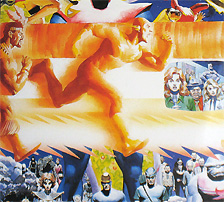
The first to appear is Johnny Quick of Earth-3, member of the Crime Syndicate. The Crime Syndicate are evil versions of the Justice League of America from a world where history and the balance of good vs. evil are reversed. Crisis on Infinite Earths opens with the destruction of Earth-3, showing that even beings as powerful as the Justice League are unable to halt the threat.
To keep them in continuity, DC would retcon the Crime Syndicate into hailing first from Qward, then from the counterpart of Earth in the anti-matter universe, in which a new Johnny Quick has taken over. This freed up Earth-3 in the 52 Multiverse for the Crime Society, an evil version of the Justice Society of America — with it’s own “golden age” Johnny Quick.
Johnny Quick and Flash: Jay Garrick, Earth-2
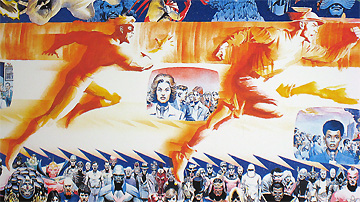
Next up are the original Golden-Age characters of Flash Jay Garrick and Johnny Quick of Earth-2. Jay Garrick was, of course, the original Flash, and as I mentioned before, he and Barry Allen inaugurated the multiverse. Johnny Quick was an inter-company response to the Flash: Because DC Comics and All-American Comics were technically different companies (though they shared a label), and Flash was an All-American character, DC introduced their own speedster — one they could own themselves — in the form of Johnny Quick. As an added bonus, he could not only run fast and perform speed tricks, but he could fly. In 1945, DC bought All-American outright, and it was the Flash who went on to lasting success. Ironically, Johnny Quick’s adventures did last slightly longer than the original Flash’s: his last adventure appeared in 1954 (Adventure Comics #207), while the Flash vanished from the newsstand in 1951 (All Star Comics #57).
Kid Flash: Wally West, Earth-1
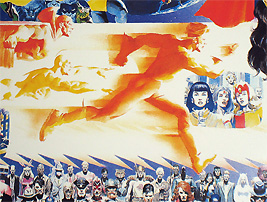
Initially, Wally West’s role was similar to that of most heroes called upon to save the universe: he fought alongside everyone else. But he had a problem: over the last few years (probably more like months in story time), his super-speed had started killing him. Every time he ran, he risked death, making his stake that much more personal. He was also the one who found Barry’s empty suit and realized just what it meant.
Fortunately for Wally (and a generation of comics readers), a blast of energy from the Anti-Monitor shocked his metabolism back to something resembling normal. He ended up stuck at a top speed near that of sound, but his powers were no longer deadly, and by the end of the series, he took up the mantle of the Flash. (This wasn’t actually a sure thing. For a long time, DC didn’t know who was going to take over, and seriously contemplated creating an entirely new character.)
Flash: Barry Allen, Earth-1
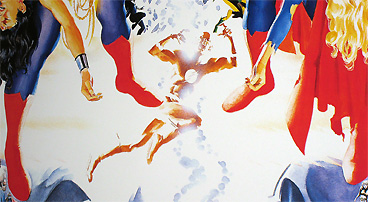
Finally, Barry Allen, the Flash who arguably launched the Silver Age of comics. DC knew going into Crisis on Infinite Earths that they wanted to kill the Flash because they were symbolically ending the Silver Age. The Flash appeared to various heroes as a spectral harbinger of doom over the first half of the series, until we saw him captured by the Anti-Monitor and tortured by his henchman, the Psycho Pirate.
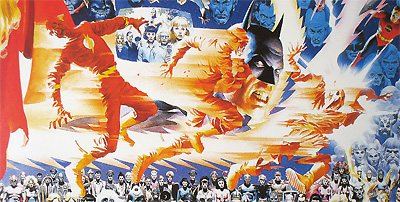
In the key issue, Crisis on Infinite Earths #8, Barry Allen escaped his prison and set about destroying a cannon with which the Anti-Monitor planned to destroy the last few universes that had escaped his wave of anti-matter. The Flash pushed beyond every record he had ever set, reaching ultimate speed and running backward in time, producing the images seen earlier in the series. In the end he died so that the universe could live, a sacrifice that inspired his successors, not just Wally West but a thousand years of future Flashes.
Other Blogs Participating
In keeping with the crossover spirit of Crisis on Infinite Earths (and all the Crises that followed), Shag of Firestorm Fan invited a bunch of fellow comics bloggers to team up today and celebrate this piece of art. While I’m featuring the Flash here, you can visit these other character-specific blogs to see how they spotlighted their own favorite characters in Crisis on Earth-Blog:
- Justice League Detroit
- The Aquaman Shrine
- I am the Phantom Stranger
- Dispatches from the Arrow Cave (Green Arrow)
- Being Carter Hall (Hawkman)
- Plastic Man Platitudes
- Mail it to Team-up
- Doom Patrol
- Firestorm Fan (ringleader of Crisis on Earth-Blog)
- Idol-Head of Diabolu (Martian Manhunter)
Thanks to the Irredeemable Shag of Firestorm Fan and Once Upon a Geek for scanning the images and organizing this blog crossover, and to Rob of The Aquaman Shrine for designing the logo!

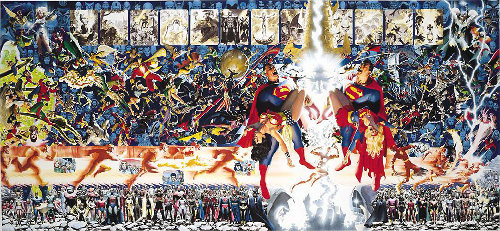
I really dig the progression of the procession of Speedsters in this painting. It always made me think of the motif during Zero Hour where a character would split into all of their possible versions.
Very cool!
Intense graphics. Coooooooool.
.-= Erik’s latest blog post: My Longhorn Boots =-.
Great analysis, but who are those two flying behind Wally-Kid Flash? Red Tornado? The other one? I don’t know. Why are they there if it’s a Flash-Speedsters timeline draw?
It’s a very cool image. I’d never seen it at poster size until last summer at a con (a booth had it taped up on the wall), and my husband and I spent aaages next to it trying to identify all the characters and find the Rogues 🙂
Minor correction – he saved the multiverse (the remainging few). 😛
Ralbalboa-
I believe that’s The Ray.
rwe1138-
Yeah, I think it is The Ray too, so now, why are they next to all the speedsters, Red Tornado and The Ray?
It always seemed to me that they were there to provide a perspective of speed. Red Tornado can fly at astounding speed and brings to mind the “Flash Fact” of how the speedsters can run through solid objects just as tornadic winds can propel debris through solid objects.
The Ray is another example of perspective because Wally and Barry are outrunning a hero who flies at the speed of light.
Kelson – Great analysis!
For the record, the others in the Flash jetstream are definitely the Ray and Red Tornado.
Also, if you look at the first image (Johnny Quick, Earth-3), you can see Impala from the Global Guardians on the far left.
Again, great job on your write-up!
The Irredeemable Shag
http://firestormfan.com
http://onceuponageek.com
.-= The Irredeemable Shag’s latest blog post: Firestorm drawing by Bubba Shelby (2009) =-.
also, there’s the Thunderbolt & someone composed of Yellow lightning (the Ray?) at the very end of the running progression. (and Reddy looks remarkably like Max Mercury there…)
.-= Jason West’s latest blog post: Rebirthing… =-.
Pingback: Eleven Blogs Crossover to Celebrate George Perez/Alex Ross Painting | Firestorm Fan